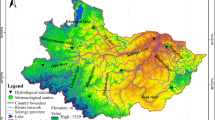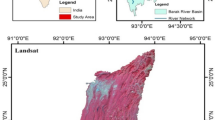Abstract
Many investigations have highlighted the importance of 32 indicators of RVA method and its modified framework in the evaluation of inter-annual and/or intra-annual low and high flow variability in river systems. Yet none of the previous investigations have taken inter-annual and intra-annual minimum e-flow variability for preserving aquatic organisms, especially in dry periods. To this end, this study proposed a procedure which consisted of modified 72 hydrologic indicators and Tennant method and applied the procedure to five sub-watersheds of Damodar catchment, India. Results showed (1) high intra-annual and inter-annual variability of all indicators within water years; (2) that none of the studied watersheds met the 10% minimum flow criterion for poor habitat conditions as recommended by Tennant method in dry years and as well as most of time none of the watersheds exhibited the availability of assured e-flow in all water years; and (3) that aquatic organisms of the catchment would become more vulnerable in the future.



















Similar content being viewed by others
Abbreviations
- \(\overline{e }\) :
-
Mean of 10% most extreme event
- \({x}_{ij}\) :
-
Seasonal precipitation at ith rain gauge station and jth observation,
- \(\beta\) :
-
Scale parameter
- \(\alpha\) :
-
Shape parameter
- \(\sigma\) :
-
Standard deviation
- \({x}_{im}\) :
-
Long-term seasonal mean
- \(\Gamma \left(\alpha \right)\) :
-
Gamma function
- \({x}_{jm}\) :
-
Long-term mean precipitation for the jth time step of the year
- \({x}_{i,j}\) :
-
Precipitation value for ith year and jth time step of the year
- \({y}_{i,j}\) :
-
Precipitation anomaly for the ith year and jth time step of the year
- \(\pm SF\) :
-
Scaling factor
- %AAF:
-
Percentage annual average flow
- g(x):
-
Cumulative gamma distribution fitted to the non-zero rainfall data (x)
- g(x):
-
Probability distribution function
- H(x):
-
CDF of mixed probability distribution of rainfall series for the concerned month
- m:
-
Rank of the dataset arranged in descending order
- N:
-
Number of precipitation observations.
- n:
-
Number of flow measurements
- p :
-
Cumulative probability
- q :
-
Probability of a zero considering, computed as M/N
- M:
-
Number of all zeros in a precipitation time series
- x > 0:
-
Amount of precipitation
- AFDC:
-
Annual Flow Duration Curve
- DRB:
-
Damodar River Basin
- DRM:
-
Desktop Reserve Model
- DVC:
-
Damodar Valley Corporation
- FDC:
-
Flow Duration Curve
- FDCA:
-
Flow Duration Curve Analysis
- IHA:
-
Indicators of Hydrologic Alteration
- MMFs:
-
Mean Monthly Flows
- mRAI:
-
Modified Rainfall Anomaly Index
- RVA:
-
Range of Variability Approach
- SFDC:
-
Stochastic Flow Duration Curve
- SPAI:
-
Standardized Precipitation Anomaly Index
- SPI:
-
Standardized Precipitation Index
- WCD:
-
World Commission on Dams
- %AAF:
-
Percentage Annual Average Flow
References
Acreman M, Dunbar MJ (2004) Defining environmental river flow requirements-a review. Hydrol Earth Syst Sci 8:861–876
Agarwal A, Chak A (1991) Floods, flood plains and environmental myths. State of India’s environment, a citizens’ report 3. New Delhi, Centre for Science and Environment, p 167
Amrit K, Mishra SK, Pande RP et al (2019) Standardized precipitation index-based approach to predict environmental flow condition. Ecohydrology :e2127. https://doi.org/10.1002/eco.2127
Bunn SE, Arthington AH (2002) Basic principles and ecological consequences of altered flow regimes for aquatic biodiversity. Environ Manag 30:492–507
Chanda K, Maity R (2015) Meteorological drought quantification with Standardized Precipitation Anomaly Index (SPAI) for the regions with strongly seasonal and periodic precipitation. J Hydrol Eng (ASCE) 20(12):06015007-1–06015007-8. https://doi.org/10.1061/(ASCE)HE.1943-5584.0001236
Chaudhuri D (2018) Behaviour and significance of reservoir evaporation and seepage losses – an experience of four reservoirs in Damodar River Valley, India. ISH J Hydraul Eng 27(3):309–326. https://doi.org/10.1080/09715010.2018.1544854
Chaudhury RR, Sobrinho JAH et al (1998) Dissolved oxygen modeling of the Blackstone River (Northeastern United States). Water Res 32:2400–2412
Delaware Water Supply (2004) The “100-year drought” of 2002
Dyson M, Bergkamp G, Scanlon J (eds) (2003). Flow. The essentials of environmental flows. IUCN, Gland Switzerland and Cambridge, UK
Edwards DC, McKee TB (1997) Characteristics of 20th century drought in the United States at multiple time scales. Climatology Rep 97–2, Department of Atmospheric Science, Colorado State University, Fort Collins, Colorado
Efstratiadis A, Tegos A, Varveris A et al (2014) Assessment of environmental flows under limited data availability: case study of the Acheloos River. Greece Hydro Sci J 59(3–4):731–750. https://doi.org/10.1080/02626667.2013.804625
Environmental and Social Impact Assessment (ESIA) Report, for West Bengal Major Irrigation and Flood Management Project (WBMIFMP), 2018, IWD, Govt. of West Bengal, 1–2
Flynn RH (2003) A stream-gaging network analysis for the 7-day, 10-year annual low flow in New Hampshire streams. U.S. Geological Survey Water-Resources Investigations Report 03- 4023, p 31
Gasith A, Resh VH (1999) Streams in Mediterranean climate regions: Abiotic influences and biotic responses to predictable seasonal events. Annu Rev Ecol Syst 30:51–81
Gu R, Dong M (1998) Water quality modeling in the watershed-based approach for waste load allocations. Water Sci Technol 38:165–172
Gupta AD (2008) Implication of environmental flows in river basin management. Phys Chem Earth 33:298–303
Hänsel S, Schucknecht A, Matschullat J (2015) The modified Rainfall Anomaly Index (mRAI)-is this an alternative to the Standardised Precipitation Index (SPI) in evaluating future extreme precipitation characteristics ? Theoret Appl Climatol 123:827–844
Huang Q, Li Q, Zhang ZZ et al (2007) Improvement Tennant method and application it to compute eco-environmental water requirement in Yellow river. J Hydrodynam (Ser. A) 22(06):774–781
Hughes DA, Hannart P (2003) A desktop model used to provide an initial estimate of the ecological instream flow requirements of rivers in South Africa. J Hydrol 270:167–181
ICOLD (2011) World register of dams. ICOLD, Paris
Imhof JG, Brown D (2003) Guaranteeing environmental flows in Ontario’s rivers and streams. A Position Statement prepared by Trout Unlimited Canada & Ontario Federation of Anglers and Hunters, p 7
Jain SK, Kumar P (2014) Environmental flows in India: towards sustainable water management. Hydrol Sci J 59(3–4):751–769
Jha R, Sharma KD, Singh VP (2008) Critical appraisal of methods for the assessment of environmental flows and their application in two river systems of India. KSCE J Civ Eng 12(3):213–219
Jones G (2002) Setting environmental flows to sustain a healthy working river. Watershed, February 2002. Cooperative Research Centre for Freshwater Ecology, Canberra
Ma L, Wang H, Qi C et al (2019) Characteristics and adaptability assessment of commonly used ecological flow methods in water storage and hydropower projects, the case of Chinese river basins. Water 11(10):2035. https://doi.org/10.3390/w11102035
McCartney M (2009) Living with dams: managing the environmental impact. Water Policy 11(1):121–139
McKee TB, Doesken NJ, Kleist J (1993) The relationship of drought frequency and duration to time scales. Proceedings of the Eighth Conference on Applied Climatology. American Meteorological Society, Boston
McKee TB, Doesken NJ, Kleist J (1995) Drought monitoring with multiple time scales. Proceedings of the Ninth Conference on Applied Climatology. American Meteorological Society, Boston
Mishra SK, Amrit K, Pandey RP (2019) Correlation between tennant method and standardized precipitation index for predicting environmental flow condition using rainfall in Godavari Basin. Paddy Water Environ. https://doi.org/10.1007/s10333-019-00747-w
Nikghalb S, Shokoohi A, Singh VP et al (2016) Ecological regime versus minimum environmental flow: Comparison of results for a river in a semi mediterranean region. Water Resour Manag 30:4969–4984
Overton IC, Smit DM, Dalton J et al (2014) Implementing environmental flows in integrated water resources management and the ecosystem approach. Hydro Sci J 59(3–4):860–877
Pathak CR (1980) Development in the Damodar valley region, India. Habitat Int 5(5–6):617–635. https://doi.org/10.1016/0197-3975(80)90005-3
Pettit NE, Bayliss P, Davies PM et al (2011) Seasonal contrasts in carbon resources and ecological processes on a tropical floodplain. Freshw Biol 56:1047–1064
Poff NL (2009) Managing for variability to sustain freshwater ecosystems. J Water Resour Plan Manag ASCE 21:435–456
Poff NL, Alla JD, Bain MB et al (1997) The natural flow regime. Bioscience 47(11):769–784. https://doi.org/10.2307/1313099
Postel S, Richter B (2003) Rivers for life: managing water for people and nature. Island Press, Washington, D.C.
Ren K, Huang S, Huang Q et al (2018) Environmental flow assessment considering inter- and intra-annual streamflow variability under the context of non-stationarity. Water 10:1737. https://doi.org/10.3390/w10121737
Revenga C, Brunner J, Henninger N, Kassem K, Payne R (2000) Pilot analysis of global ecosystems: freshwater systems. World Resources Institute, Washington, DC
Richter BD, Baumgartner JV, Powell J et al (1996) A method for assessing hydrologic alteration within ecosystems. Conserv Biol 10(4):1163–1174
Richter B, Baumgartner JV, Wigington R et al (1997) How much water does a river need ? Freshw Biol 37:231–249. https://doi.org/10.1046/j.1365-2427.1997.00153.x
Rosenberg DM, McCully P, Pringle CM (2000) Global-scale environmental effects of hydrological alterations: introduction. Bioscience 50:746–751
Sabater S, Bregoli F, Acuña V et al (2018) Effects of human-driven water stress on river ecosystems: a meta-analysis. Sci Rep 8:11462. https://doi.org/10.1038/s41598-018-29807-7
Shiau JT, Wu FC (2007) Pareto-optimal solutions for environmental flow schemes incorporating the intra-annual and inter-annual variability of the natural flow regime. J Water Resour Res 43:W06433. https://doi.org/10.1029/2006WR005523.(5),395-404
Smakhtin VU (2001) Low flow hydrology: a review. J Hydrol 240:147–186
Smakhtin VU, Shilpakar RL, Hughes DA (2006) Hydrology based assessment of environmental flows: an example from Nepal. Hydro Sci J 51(2):207–222. https://doi.org/10.1623/hysj.51.2.207
Stromberg JC, Beauchamp VB, Dixon MD et al (2007) Importance of low-flow and high-flow characteristics to restoration of riparian vegetation along rivers in arid south-western United States. Freshw Biol 52:651–679. https://doi.org/10.1111/j.1365-2427.2006.01713.x
Sugiyama HV, Vudhivanich AC, Lorsirirat WK (2003) Stochastic flow duration curves for evaluation of flow regimes of rivers. J Amer Water Resour Assoc 39(1):47–58
Svoboda M, LeComte D, Hayes M et al (2002) The drought monitoring. Bull Am Meteorol Soc 83:1181–1190
Tennant DL (1976) Instream flow regimens for fish, wildlife, recreation and related environmental resources. Fisheries 1:6–10. https://doi.org/10.1577/1548-8446(1976)001%3c0006:IFRFFW%3e2.0.CO;2
Tharme RE (2003) A global perspective on environmental flow assessment: emerging trends in the development and application of environmental flow methodologies for rivers. River Res Appl 19:397–442
Van Rooy MP (1965) A rainfall anomaly index (RAI) independent of time and space. Notos 14:43–48
Verma RK, Murthy S, Verma S et al (2016) Design flow duration curves for environmental flows estimation in Damodar River Basin, India. Appl Water Sci :339–349. https://doi.org/10.1007/s13201-016-0486-0
WCD (2000) Dams and development: a new framework for decision-making. Earthscan, London
WCD (2011) World Commission on Dams. IUCN, Gland
Whipple AA, Viers JH (2019) Coupling landscapes and river flows to restore highly modified rivers. Water Resour Res 55(6):4512–4532
WWAP (2012) Managing water under uncertainty and risk: 4th World Water Development Report. Colombella: World Water Assessment Programme, UNESCO
Yulianti JS, Burn DH (1998) Investigating links between climatic warming and low streamflow in the Prairies region of Canada. Can Water Resour J 23:45–60
Zarfl C, Lumsdon AE, Berlekamp J et al (2015) A global boom in hydropower dam construction. Aquat Sci 77(1):161–170
Acknowledgements
The authors are thankful to the Maithon Reservoir Office, DVC, Maithon for providing daily rainfall and discharge data. First author is also thankful to IIT Roorkee for providing Post Doctoral Fellowship and necessary support to carrying out the study.
Author information
Authors and Affiliations
Corresponding author
Ethics declarations
Conflicts of Interest
The authors declare no conflict of interest.
Additional Information
No additional information is available for this paper.
Additional information
Publisher's Note
Springer Nature remains neutral with regard to jurisdictional claims in published maps and institutional affiliations.
Rights and permissions
Springer Nature or its licensor (e.g. a society or other partner) holds exclusive rights to this article under a publishing agreement with the author(s) or other rightsholder(s); author self-archiving of the accepted manuscript version of this article is solely governed by the terms of such publishing agreement and applicable law.
About this article
Cite this article
Verma, R.K., Pandey, A., Mishra, S.K. et al. A Procedure for Assessment of Environmental Flows Incorporating Inter- and Intra-Annual Variability in Dam-Regulated Watersheds. Water Resour Manage 37, 3259–3297 (2023). https://doi.org/10.1007/s11269-023-03502-3
Received:
Accepted:
Published:
Issue Date:
DOI: https://doi.org/10.1007/s11269-023-03502-3




